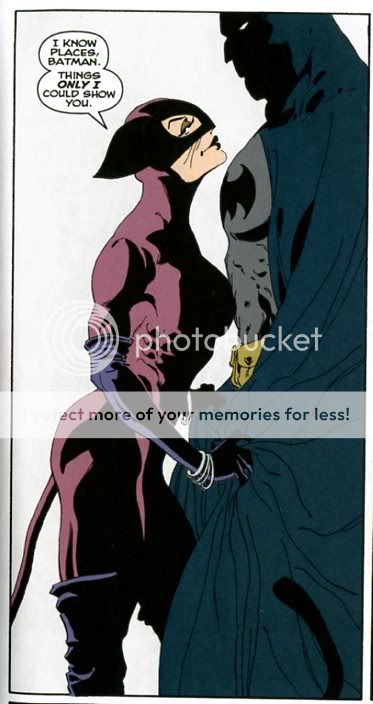I’ve been sort of half meaning to read the Long Halloween for a while. I’ve seen some of Tim Sale’s art before…mainly when he did that Comics Journal cover a little while back, I think. Anyway, I like his work; he has a nice clean design sense, with good use of blacks and dark areas especially. His character designs are striking too; he manages to be cartoony in a way that doesn’t seem to come either from manga or from humor comics. Instead he seems more directly influenced by art nouveau…or perhaps it’s just Frank Miller. I don’t necessarily love everything he does. I find his Catwoman design kind of meh, for example; the purple suit seems overly angular and drab, and I don’t share his obsession with abs for all.
But even so, the panel is competently blocked and consistently stylized. It’s professional, damn it. And some moments are in fact inspired, like this Joker as Christmas- Grinch sequence…
The way the Joker’s body is all folded up in that first panel, and then the veins in his eye shot through the magnifying glass…that’s fine storytelling. It’s worth looking at.
And then there’s the story. I think that, maybe, if you really want to appreciate Dark Knight, you should read The Long Halloween. It’s easy to look back at Frank Miller’s writing and sneer at the grim and gritty Batman, the hard-boiled repetitive dialogue (“this would be a good death”), etc. etc. But, damn it, there was a ton of humor and energy there as well; his Joker, for example, was genuinely, viciously funny (dressing Selina Kyle up as Wonder Woman — what the hell? or calmly stating “I’m going to kill everyone in this room” — to which the David Lettermen analog gives the pitch-perfect response, “Now that’s darn rude!”) And his Batman had a real voice and inner life — stolen from all those pulp sources, of course, and over-the-top, but still, in part for those reasons, memorable and even nuanced. I loved that moment at the end of the book where he tells Robin to sit up straight for example; he’s both this grim avenger and this crotchety father figure. He’s perfect, and the perfection is played as a cantankerous tic. Certainly, the book is dark in that people get killed and there’s blood and it’s for grown-ups, more or less. But it’s not dark in the sense of being dreary. It’s filled with ideas and weird jokes and satire and a lot of love for the characters and for imaginative possibilities.
The Long Halloween, on the other hand, has no imaginative possibilities to offer. Forget Miller’s occasional forays into society and politics and mortality — Jeph Loeb doesn’t even have anything to say about Batman or his rogues gallery. Sale makes sure everyone looks great, but that can’t hide the fact that the designated writer has the proportional spunk and gumption of an actuary on quaaludes. The Scarecrow wears straw and the Mad Hatter speaks wiTh FuNny caPs — that’s about as much personality as Loeb can offer. They might as well all just stand around telling each other, “Um…die, Batman. I’m really nuts. No, no, I am. Die.” Except that would be marginally entertaining, wouldn’t it? Instead the Joker laughs and the Catwoman does her Catwoman ooh-I’m-ambivalently-evil thing, and Batman wanders around stiffly, sticking out his muscles, muttering the same few lines over and over (“I believe in Harvey Dent.”), and painfully clanking forth some insight from the old Frank Miller scripts he probably reads before going to bed (don’t wear the costume in the day — check. Got that in Year One. Thanks.) The mafia guys are similarly lackluster,the third-hand Godfather cliches played with so little sense of irony that the best joke in the book ( instead of the good-guy mafiosos refusing to move into drugs, they refuse to move into super-villains) just sort of sits there looking confused and pitiful.
Plopped down in the middle of such dreary, derivative schlock, the book’s iterated tagline, “I believe in Gotham City,” comes across as neither inspiration nor bittersweet aspiration, but as callow fanboy special pleading. Because you know what? This is going to come as something of a shock, but…Gotham City? It’s not real. You want me to suspend disbelief, you need to put in some effort and some genius. Because simply asserting that your little corporate fan-fic fantasyland has profound meaning makes you seem like some kind of aesthetic mosquito, battened desperately on the decaying carcasses of past minimally talented Batscripters. Suck mightily as you will, though, that juice is gone. All you can get out of those corpses is a dry slurping noise, which sounds mighty empty as it echoes about in your doddering edifice of piffle.
And of course since no character in the entire exercise has anything like an actual personality, the inevitable twist ending comes across as utterly gratuitous. Oh my God, the killer is — Harvey Dent’s wife! That’s so profound because, like, she was such an utterly boring, stereotypical whiny wife throughout the whole book, and now…she’s still an utterly boring, stereotypical whiny wife, but with a plot arc cribbed from Scott Turow.
Oh, wait, did I spoil the end? Sorry. Guess you won’t want to read it now.
Maybe you could just look at the art?


